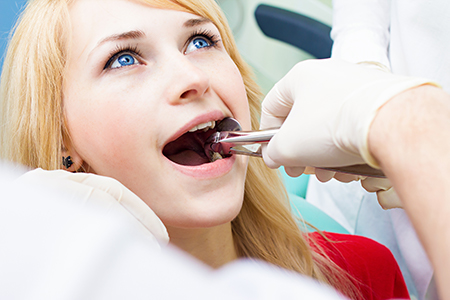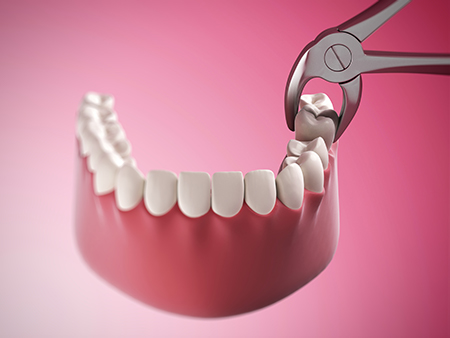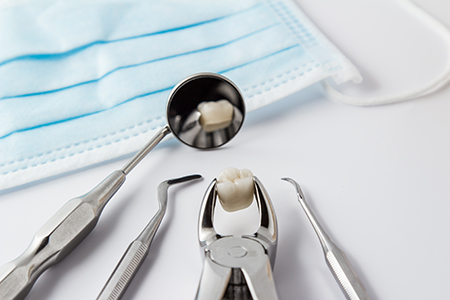New Patients
(865) 876-7050
Existing Patients
(865) 947-2220

Deciding to remove a tooth is never taken lightly. Our priority is to preserve natural teeth whenever possible, but there are clear clinical scenarios where extraction is the safest, most predictable path to protect your overall oral health. When preservation would leave you at risk for infection, ongoing pain, or damage to neighboring teeth, removing the problem tooth can be the most responsible option.
Every extraction begins with a careful evaluation: we review your medical history, examine the tooth and surrounding tissues, and use imaging to see what lies beneath the surface. This comprehensive approach helps us match the procedure to your unique situation and helps you understand the rationale for removal so you can make an informed decision.
Comfort and safety are central to the process. We tailor anesthesia and sedation options to your comfort needs and medical profile, and we plan any follow-up care or restorative steps—such as tooth replacement—before you leave the office. Our aim is to remove uncertainty and replace it with clarity, predictable healing, and a clear plan for the next step.
Primary (baby) teeth that won’t let go
Sometimes a primary tooth remains in place longer than it should because its root hasn’t resorbed or it becomes fused to the jawbone. When an over-retained baby tooth interferes with the eruption and alignment of the permanent tooth, timely removal can prevent future crowding and orthodontic complications.
Permanents that are too damaged to repair
Advanced decay can destroy the structural integrity of a tooth so extensively that restoration is no longer feasible. In those circumstances, extraction eliminates a source of pain and infection and prevents the problem from spreading to adjacent teeth or into the jaw.
Teeth that are fractured beyond restoration
Severe cracks or fractures—especially those that extend below the gum line or into the root—can render a tooth non-restorable. When the root or supporting structure is compromised, removing the tooth is often the safest option to avoid repeated procedures and ongoing discomfort.
Advanced periodontal disease
Periodontal (gum) disease can progressively destroy the bone and soft tissues that hold teeth in place. In advanced cases, extraction may be needed to eliminate mobile or non-salvageable teeth and to allow periodontal therapy to stabilize the surrounding structures.
Impacted or problematic wisdom teeth
Third molars commonly lack adequate room to erupt properly. When they are impacted, misaligned, repeatedly infected, or a threat to adjacent teeth, removing them can prevent chronic pain, cysts, and damage to neighboring molars.
Extractions as part of orthodontic planning
When there is a mismatch between tooth size and jaw space, selective removal of permanent teeth may be part of a comprehensive orthodontic plan to create the space needed for proper alignment and a stable bite.

Before any procedure begins, we confirm your medical history, medications, and any allergies so we can plan safely. If you are on blood thinners, have cardiac conditions, or take specific medications, we coordinate with your physician as needed to minimize risks and ensure appropriate management around the time of treatment.
We routinely use updated imaging to evaluate root shape, proximity to vital structures, and the overall condition of the jawbone. That information guides whether a simple in-office extraction will suffice or if referral to an oral and maxillofacial surgeon is the safest option for a more complex removal.
Local anesthesia is the foundation of pain control for most extractions. For patients who feel anxious or require deeper relaxation, we discuss additional sedation options so that the appointment is as calm and comfortable as possible. Before we begin, we explain each step so you know what to expect and can ask questions.
A simple extraction applies when the tooth is fully visible and the roots are reasonably shaped. After numbing the area, the dentist gently loosens the tooth and removes it with specialized instruments. The focus is quick, controlled removal with minimal trauma to surrounding tissues and clear instructions for a smooth recovery.
Surgical extraction is recommended when a tooth is broken at the gum line, impacted, or fused to the bone. The procedure may include a small incision, removal of a tiny portion of bone, or sectioning the tooth to remove it safely. We explain any additional steps, discuss post-operative expectations, and coordinate with specialists when the procedure is beyond the scope of routine office care.

Healing after an extraction follows a predictable course, and most patients can return to normal activities within a few days. Still, proper at-home care is crucial to avoid complications such as infection or a dry socket. We provide clear, personalized instructions and emphasize actions that protect the forming blood clot and support tissue repair.
Managing discomfort and swelling often involves simple measures—timed ice application, over-the-counter pain relievers (as appropriate), and short-term prescription medication for more significant pain when necessary. Follow the dosing guidance we provide and reach out if pain increases or changes character.
Maintaining oral hygiene around the extraction site is important but must be done gently. We advise when and how to resume brushing, and when to begin gentle rinsing with a saline solution to keep the area clean without disturbing healing tissues.
Control bleeding with consistent pressure
Bite down on the provided gauze for the time recommended to encourage clot formation. If bleeding persists, replace the gauze as instructed and maintain firm, steady pressure—this is usually effective in the first several hours after the procedure.
Protect numb tissues
Avoid chewing, eating, or touching the area until numbness fully resolves. A numb lip or tongue can easily be bitten, leading to injury and slowed healing.
Take medicines exactly as directed
Antibiotics:
If a course of antibiotics is prescribed, complete it as instructed to reduce the chance of infection.
Pain control:
Start your pain regimen at the recommended time so discomfort is minimized as the local anesthetic wears off. Use over-the-counter options unless a prescription is provided and always follow our guidance.
Avoid actions that dislodge the clot
Do not rinse forcefully, spit, use straws, or smoke for the first several days. These activities can disturb the clot and increase the risk of a painful condition called dry socket.
Manage swelling with ice
An ice pack applied intermittently in the first 24 hours helps minimize swelling. Apply for short cycles—typically ten minutes on, ten minutes off—to reduce discomfort.
Choose soft, nourishing foods
Stick to cool or lukewarm soft foods for the first few days and stay well hydrated. Avoid spicy or very hot items until healing progresses.
Gentle oral care
Continue regular oral hygiene while being careful around the extraction site. After the initial period, gentle saltwater rinses can help keep the area clean and comfortable.
Attend your follow-up
If sutures were placed or if we need to monitor healing, keep your scheduled follow-up appointment so we can confirm recovery is progressing as expected.
If you notice increasing pain, persistent bleeding, swelling that worsens after a few days, or an unusual taste or odor, contact our office promptly so we can evaluate and address any concerns.

Removing a tooth can be an important step toward restoring oral health, but it’s also part of a broader plan to preserve chewing function, facial support, and long-term dental stability. We discuss replacement options early so you understand how different solutions affect function, appearance, and future maintenance.
Common restorative choices include removable partial dentures, fixed bridges, and dental implants. Each option has clinical considerations—such as bone availability, adjacent tooth health, and long-term maintenance—that we review with you so decisions are aligned with your goals and lifestyle.
When implants are appropriate, they offer a highly predictable way to restore a single tooth or multiple teeth while helping preserve bone and neighboring tooth structure. If implants are not indicated, bridges or well-made partial dentures can often meet functional and esthetic needs when designed carefully.
At the office of Kennedy Dentistry, our approach to extractions centers on careful diagnosis, empathetic communication, and coordinated follow-up care. We take time to explain why removal is recommended, what the procedure will involve, and how recovery will be managed so you feel confident every step of the way.
Our goal is to treat each patient as an individual—planning treatments that respect their health history, comfort level, and long-term oral goals. When complex needs arise, we coordinate with specialists to ensure the safest, most effective outcome.
In summary, tooth extraction is a common, well-understood procedure that, when performed for the right reasons and followed by appropriate care, can resolve pain, remove infection, and set the stage for long-term oral health. If you have questions about extractions or want to discuss a specific concern, please contact us for more information.
The most common reasons for tooth loss include advanced periodontal disease, extensive tooth decay, and facial trauma. According to statistics, gum disease is responsible for close to 70% of tooth loss in adults. Although less frequent than the preceding three reasons, it should also be noted that specific diseases, drugs, smoking, and poor nutrition contribute to the risk of tooth loss.
The Centers for Disease Control and Prevention report that in the United States, an average of 12 teeth (including the wisdom teeth) are lost by the age of 50. Also, 26% of adults between 65 and 74 years of age have lost all their teeth.
Every patient and every situation is different. However, when a tooth and the surrounding tissues are numbed with a local anesthetic, you should only expect to feel a bit of pressure, but no pain as the tooth is being loosened from the surrounding tissues and extracted. For patients who are apprehensive and for some surgical extractions, our office will discuss our options in dental sedation to provide further relaxation and reduce any sense of discomfort.
While it's normal to feel some tenderness and swelling following an extraction, the degree of these sensations can vary. It mostly depends on the complexity of the extraction and the body's response to the procedure. We'll recommend or prescribe the appropriate pain medication to help ensure your comfort and give you specific instructions for maximum effectiveness and safety.
Typically, the recovery period following a simple extraction is shorter than a surgical extraction. However, a patient's overall health, habits, the size and location of the tooth, and other variables can influence recovery and healing. To speed up the recovery and avoid any complications, patients must follow the given at-home instructions diligently. We'll carefully review what to expect following your procedure and go over your post-op instructions.
Smoking interferes with blood clot formation, which is an essential first step in the healing process. Blood clot formation not only provides a protective layer to cover the underlying exposed bone and nerve endings, but it also supports the growth of new tissue. Cigarette smoke also contains chemical toxins that can disrupt the healing process and lead to problems such as continued inflammation, infection, or dry socket.
In a very small percentage of cases, a condition known as dry socket can develop in the aftermath of a dental extraction. This painful condition can arise when the blood clot in the extraction site doesn't form properly or gets dislodged. With dry socket, you may experience throbbing pain and symptoms such as bad breath and an unpleasant taste in your mouth. As skilled providers of care, our office will provide immediate treatment to alleviate your discomfort and promote healing.
The last teeth in your mouth to develop, wisdom teeth often do not have enough room to fully erupt or may be positioned in the wrong direction. These issues can affect your dental health as well as overall wellbeing. While some individuals never develop all their wisdom teeth, and a few have sufficient space for them, there are many people with partially or fully impacted third molars. Our office will monitor the development, position, and health of your wisdom teeth and will advise you if and when extractions are indicated.
After a tooth is removed, bone-grafting material is sometimes placed in the socket to promote healing and encourage new bone development. This procedure is often performed to support the eventual and successful placement of a dental implant.
At the office of Kennedy Dentistry, we strive to make dental care affordable and accessible. Depending on the type or complexity of the extraction and other variables, the cost of the procedure can vary. Based on our diagnostic findings, our office will inform you of the healthiest choices in care, explain the fees, discuss insurance coverage, and explain your payment options.
Many dental plans offer some level of coverage for tooth extractions. We'll advise you if your plan covers the full cost of the procedure and if there is any out-of-pocket expense. Our business office will work with you to maximize your insurance benefits as much as possible while helping you minimize any out-of-pocket expenses.
